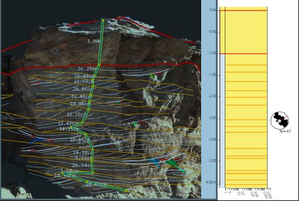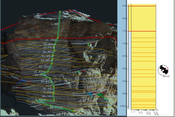Information
- Publication Type: PhD-Thesis
- Workgroup(s)/Project(s):
- Date: December 2020
- TU Wien Library:
- Open Access: yes
- 1st Reviewer: Michael Sedlmair
- 2nd Reviewer: Barbora Kozlikova
- Rigorosum: 12. March 2021
- First Supervisor: Eduard Gröller

- Pages: 116
- Keywords: Interactive Visualization, Integration Spatial and Non-Spatial Data Visualization, Methodology
Abstract
In many domains, such as urban planning, civil engineering, or disaster management, analysts
need to deal with complex geometric data that also contain multivariate attributes. In addition to
the visual analysis of the attribute data, typical tasks involve the localization and understanding
of shapes, and judging spatial relations between geometric objects and the surrounding geometry,
as for instance a digital terrain model. One way to address this in a visualization design is with
coordinated multiple views, combining a 3D geometric view and attribute views by brushing
& linking. However, a naive coordination of such views highlights challenges inherent to 3D
visualization, as brushed objects may be occluded or lie outside of the current viewing volume.
This can easily lead to disorientation and failing of localization, shape understanding, and spatial
relation tasks, which ultimately breaks the iterative analysis loop provided through coordinated
multiple views.
In this thesis we explore different visual integration approaches for combining geometric and
attribute views with respect to three application domains. In the first chapter, we deal with the
domain of tunnel inspection and documentation, concerned with revealing patterns in tunnel
crack data. We integrate a 3D geometric view with multiple attribute views to a coordinated
multiple view solution and present several domain-specific visualization and interaction strategies
to overcome the aforementioned challenges. We conclude the chapter with a methodological
framework that provides visualization designers with integration guidelines regarding ‘Guided
Navigation’, ‘Enhanced Geometric Rendering’, and ‘Similarity-based Analysis’.
In the second chapter, we explore the potential visual impact of candidate buildings to a cityscape
in the context of visibility-aware urban planning. We present the visualization system Vis-A-Ware
to qualitatively and quantitatively evaluate and compare visibility data of candidate buildings
with respect to a large number of viewpoints. Vis-A-Ware features a 3D view of an urban scene
and a novel ranking view to compare and filter candidates with respect to visual impact data
derived from visibility evaluations. The ranking view is tightly integrated with the other views
for qualitative evaluation and to judge spatial relations in the cityscape. We provide users with a
workflow to ultimately arrive at a small set of candidates supporting a jury-based decision-making
process.
In the third chapter, we are concerned with the domain of geological analysis of digital outcrop
models (DOMs) which plays an essential role in the current NASA and ESA missions seeking
signs of past life on Mars. Geologists interpret and measure DOMs, create sedimentary logs, and
combine them in ‘correlation panels’. Currently, the creation of correlation panels is manual and therefore time-consuming, and inflexible. With InCorr we present a visualization solution that
encompasses a 3D logging tool and an interactive data-driven correlation panel that evolves with
the stratigraphic analysis. Correlation panels are an important part of geological publications.
With InCorr we provide geologists with an interactive correlation panel that is reproducible and
takes significantly less effort to create.
The results of this thesis demonstrate that the tight integration of 3D geometric and attribute
views is essential for certain domains and needs to be approached in a methodological way with
thoughtful visualization and interaction design.
Additional Files and Images
Additional images and videos
Additional files
Weblinks
BibTeX
@phdthesis{Ortner_PhD,
title = "Tight Integration of Visual Analysis and 3D Real-Time
Rendering",
author = "Thomas Ortner",
year = "2020",
abstract = "In many domains, such as urban planning, civil engineering,
or disaster management, analysts need to deal with complex
geometric data that also contain multivariate attributes. In
addition to the visual analysis of the attribute data,
typical tasks involve the localization and understanding of
shapes, and judging spatial relations between geometric
objects and the surrounding geometry, as for instance a
digital terrain model. One way to address this in a
visualization design is with coordinated multiple views,
combining a 3D geometric view and attribute views by
brushing & linking. However, a naive coordination of such
views highlights challenges inherent to 3D visualization, as
brushed objects may be occluded or lie outside of the
current viewing volume. This can easily lead to
disorientation and failing of localization, shape
understanding, and spatial relation tasks, which ultimately
breaks the iterative analysis loop provided through
coordinated multiple views. In this thesis we explore
different visual integration approaches for combining
geometric and attribute views with respect to three
application domains. In the first chapter, we deal with the
domain of tunnel inspection and documentation, concerned
with revealing patterns in tunnel crack data. We integrate a
3D geometric view with multiple attribute views to a
coordinated multiple view solution and present several
domain-specific visualization and interaction strategies to
overcome the aforementioned challenges. We conclude the
chapter with a methodological framework that provides
visualization designers with integration guidelines
regarding ‘Guided Navigation’, ‘Enhanced Geometric
Rendering’, and ‘Similarity-based Analysis’. In the
second chapter, we explore the potential visual impact of
candidate buildings to a cityscape in the context of
visibility-aware urban planning. We present the
visualization system Vis-A-Ware to qualitatively and
quantitatively evaluate and compare visibility data of
candidate buildings with respect to a large number of
viewpoints. Vis-A-Ware features a 3D view of an urban scene
and a novel ranking view to compare and filter candidates
with respect to visual impact data derived from visibility
evaluations. The ranking view is tightly integrated with the
other views for qualitative evaluation and to judge spatial
relations in the cityscape. We provide users with a workflow
to ultimately arrive at a small set of candidates supporting
a jury-based decision-making process. In the third chapter,
we are concerned with the domain of geological analysis of
digital outcrop models (DOMs) which plays an essential role
in the current NASA and ESA missions seeking signs of past
life on Mars. Geologists interpret and measure DOMs, create
sedimentary logs, and combine them in ‘correlation
panels’. Currently, the creation of correlation panels is
manual and therefore time-consuming, and inflexible. With
InCorr we present a visualization solution that encompasses
a 3D logging tool and an interactive data-driven correlation
panel that evolves with the stratigraphic analysis.
Correlation panels are an important part of geological
publications. With InCorr we provide geologists with an
interactive correlation panel that is reproducible and takes
significantly less effort to create. The results of this
thesis demonstrate that the tight integration of 3D
geometric and attribute views is essential for certain
domains and needs to be approached in a methodological way
with thoughtful visualization and interaction design.",
month = dec,
pages = "116",
address = "Favoritenstrasse 9-11/E193-02, A-1040 Vienna, Austria",
school = "Research Unit of Computer Graphics, Institute of Visual
Computing and Human-Centered Technology, Faculty of
Informatics, TU Wien ",
keywords = "Interactive Visualization, Integration Spatial and
Non-Spatial Data Visualization, Methodology",
URL = "https://www.cg.tuwien.ac.at/research/publications/2020/Ortner_PhD/",
}


 image
image PhD thesis
PhD thesis
